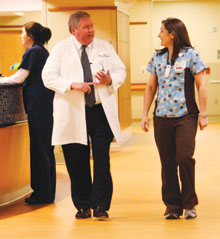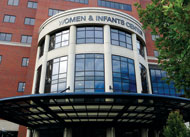Ob/Gyn Enters a New Era
By Jennifer Lollar
 |
According to Andrews (left), patients benefit from space and privacy, which enables infants to stay with mothers and families following routine or complex deliveries. |
For many expectant parents, planning the colors and design of the nursery is one of the most exciting parts of pregnancy.
Now imagine if that nursery were 10 stories tall, 430,000 square feet, and filled with the latest technological innovations, and you might get a sense of the challenge that faced UAB’s caregivers. When planning began for the UAB Women & Infants Center a decade ago, UAB ob/gyn specialists, neonatologists, pediatricians, and nurses saw it as an opportunity to reimagine how they provide expert care for patients and their families, says William Andrews, Ph.D., M.D., the new chair of the Department of Obstetrics and Gynecology. For the first time, all of UAB’s inpatient services focusing on women and babies—from gynecology, urogynecology, gynecologic oncology, and routine and high-risk obstetrics to neonatal services and reproductive endocrinology and infertility—would be housed under one roof. The new building would include plenty of space, technology, and possibilities for increasing UAB’s capacity to care for Alabama’s women and their growing families.
The clinical staff played a crucial role from the very beginning, when the building was being designed. “When this process began, hospital leadership made the conscious decision to involve our physicians and nurses to ensure we had a facility that not only was technically superior, but one that also met the needs of both our patients and staff,” says Andrews, a maternal-fetal medicine specialist and holder of the Charles E. Flowers Jr. Chair in Obstetrics and Gynecology. “Caregivers who are on our units every day know what they need to best serve our patients’ needs and what our patients need to make their stay with us as comfortable as possible.”
 |
Neonatologist Wally A. Carlo (right) says UAB’s RNICU is the only one in the state with full perinatal and cardiovascular services. |
Teams of nurses and physicians combed publications related to innovations in design, looked at studies and opinion papers on the Center for Healthcare Design’s Web site, and considered facility layouts published in Health Environments Research & Design and related journals. They also reviewed handouts and notes from past conference presentations, interviewed former patients, and traveled to other health-care institutions to see what worked and did not work for both patients and staff.
“From the start, a commitment was made to rely on the nursing staff for input into the design and operation of this facility,” says Elicia Daley, R.N., M.S.N., administrative director of women and infants’ services at UAB. “During the schematic design phase, members of the nursing leadership team visited several hospitals in the country to learn more about new concepts in women’s and infants’ care. Following these trips, we shared photographs and information on the most up-to-date designs with the project planning team.” Daley adds that several nurses were actively involved in the development of the final design and construction documents; before the facility’s completion, mock-up rooms allowed the staff to test their designs and identify logistical issues prior to moving in and opening the center. “Involvement in the building’s design has given our nurses the ability to provide more efficient care to each patient,” Daley says.
Privacy and Comfort
The result of all of this research, design, and construction is a facility made to match UAB’s expert ob/gyn care—and a building that fundamentally changes how women and infants receive that care. Women in labor now arrive via the center’s own driveway, with valet and surface parking located next to the front doors. Inside, the look is more world-class hotel than hospital. Labor and delivery rooms are spacious and private. Likewise, postpartum rooms are expansive and welcoming, enabling infants to room in with new mothers. To encourage family/infant bonding, the rooms also provide sleep space for fathers or support people, and family visits are welcome around the clock. Medical equipment and supplies are tucked out of sight behind wooden panels whenever possible, and rooms include amenities such as flat-screen televisions, DVD players, small refrigerators, wireless Internet access, and video game systems. Nearby, down hallways decorated in warm colors, family lounges offer computers and playrooms for young siblings; other family facilities include parent sleep rooms, laundry and shower facilities, a lactation center, and a family hospitality center. Even the meals are different, Andrews says. “It’s like hotel room service.”
Antepartum (high-risk obstetrics) rooms, designed for women requiring hospitalization prior to delivery, and all rooms dedicated to gynecology patients are private as well. The facility also includes rooms designed for patients with mobility limitations, isolation rooms with separate ventilation systems, and lead-lined rooms for gynecologic oncology patients treated with radioactive implants. “These private and specialized rooms should lead to improved patient progression and satisfaction and lower infection rates,” Andrews says.
Special Deliveries
"Babies delivered at UAB are born at the only Alabama hospital with a full-service Level IIIC Regional Newborn Intensive Care Unit (RNICU)—the highest designation possible,” says neonatologist Wally A. Carlo, M.D., Edwin M. Dixon Professor of Pediatrics and director of the Division of Neonatology. “Should problems arise, these babies will have a better chance of surviving than infants born in less well-equipped facilities.” UAB’s RNICU is the only one in the state with full perinatal and cardiovascular services, and it is staffed with neonatologists 24 hours a day.

Numerical AdvantageWhat’s Inside the 59—antepartum and postpartum rooms 56—baby Regional Newborn Intensive Care Unit 52—baby Continuing Care Nursery 30—gynecology/gynecologic oncology rooms 17—labor, delivery, and recovery rooms 13—maternity evaluation unit rooms 4—operating rooms for C-sections and other maternity-related procedures 5—room post-anesthesia recovery unit 3—well-baby nurseries |
Carlo adds that the new building’s layout makes it easier for specialists to work in unison. “The highest-risk deliveries are performed in the caesarean section room next to the RNICU, which permits seamless transport of infants to the NICU after delivery,” he explains. The maternity evaluation unit and labor and delivery area also are adjacent to the RNICU, and the first floor houses an emergency delivery and newborn-care room to handle births that arrive at the hospital in progress. The center also is set up to provide neonatal resuscitation anywhere a baby may be born in the building.
“UAB’s survival rate for all premature babies significantly exceeds the national average, as does its rate for survival without mental, auditory, and visual disabilities,” Carlo says. “In addition, our state-of-the-art carbon dioxide monitoring equipment is the only system of its kind in the state. Equipment lets us closely observe premature infants’ CO2 levels, greatly improving our ability to care for critically ill infants and reducing the need for surgical repair of pneumothorax and its associated risks.
“The facility’s design also supports our multidisciplinary family-centered model of care,” Carlo says. All rooms in the RNICU and Continuing Care Nursery are private and include sleep space for parents, which means UAB now has the largest all-private-room special-care nursery unit in the country; special rooms are available for families with multiple births. The post-anesthesia recovery unit also allows well newborns to stay with their mothers while they recover from a C-section.
Beautiful Innovation
For patients, connecting with physicians and care providers has become easier as well. Nurse work areas have been placed as close to patient rooms as possible to minimize footsteps and ensure patient visibility. Wireless systems help nurses monitor patients and provide the highest level of infant security. Each caregiver also wears a wireless, hands-free electronic communicator—much like something out of Star Trek—for instant contact with other nurses or physicians. Skybridges connect the center with the rest of UAB Hospital and eventually will link it to the new Children’s Hospital now under construction. And as before, patients have 24-hour access to UAB’s maternal-fetal medicine specialists, who can assess complications and help develop pre- and post-birth management strategies.
While the new Women & Infants Center has been built to meet current needs—UAB has experienced a 50-percent increase in demand for women’s and infants’ services over the past decade—it also has been built with an eye toward the future. “The design integrates a wide spectrum of women’s services and positions us to accommodate evolving, cutting-edge approaches to obstetrical and neonatal care” as they develop, Andrews explains.
“It’s the most technologically advanced building we have to offer,” he says. “And it’s a beautiful building that our patients and their families will enjoy visiting.”
More information
Get a closer look at the Women & Infants Center with an online photo tour.
